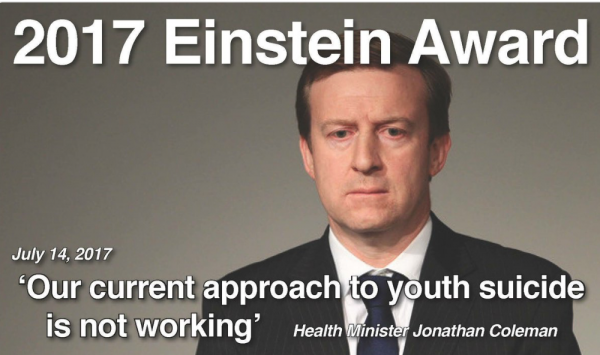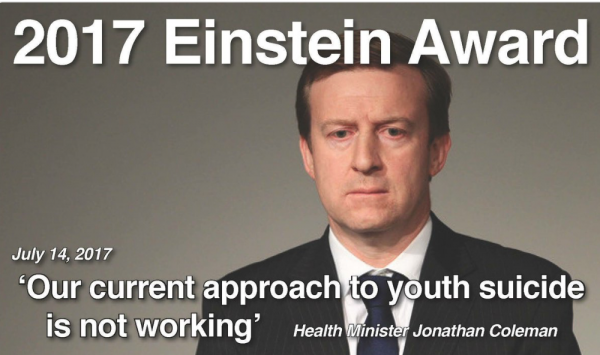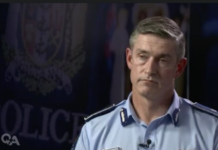
It’s been a mantra of the opponents of the previous Government’s mental health inaction policy that demand and need for mental health services has been growing exponentially in recent years, and this week at a Waikato DHB meeting I saw absolute evidence of the issue when we were presented with figures showing massive increases in two key statistics highlighting the cutting edge.
Firstly, Waikato Hospital Emergency Dept presentations for severe mental illness reasons had grown from an average of about 40 per month in 2013 and 2014 to over 160 in January 2018 – a 400% increase.
Secondly, emergency contacts with the region’s mental health crisis services had grown from an average of about 170 per month in 2013 and 2014, to 520 in January 2018 – a 300% increase.
In both cases, a sharp, almost immediate increase in these awful statistics occurred between late 2014 and mid 2015, “with no additional resources to respond to that need,” according to Vicki Aitken, the DHB’s Director of Mental Health and Addiction Services.
When questioned at the Board Committee meeting, the Clinical Director of these services, one Rees Tapsell, made two interesting comments; he claimed all public mental health services in New Zealand ‘were facing the same pressure’, and that several other areas of the DHB’s work were ‘under almost the same pressure’.
Tapsell was unable to say why these truly astounding statistics, or the more general issue of lack of resources, hadn’t led to the Government and the DHBs providing more resources to meet the community needs.
He did agree that there was a significant ‘workforce planning’ deficit in the mental health sector, and that qualified staff were difficult to come by, and hard to keep hold of – in part due to the attractiveness of the significantly higher salaries in the public mental health sector in Australia.
Also discussed was the effect on the workers in the mental health services, with Aitken’s report stating “While all areas of our service are under significant stress, some areas are now having staff whom are visibly distressed by the workload and the limited ability to respond to referrals. This is particularly true in the Infant, Child and Adolescent Mental Health Team.”
Shockingly, this sort of information would have been known for some time by senior hospital managers, clinicians and – I believe Board members, Ministry of Health officials and the Minister himself, if not in complete detail, at least in terms of the trends and overall state of affairs – yet we’ve have officials at our DHB, other DHB’s, the Ministry and the sector generally all following the Minister’s lead and denying the problem was out of hand; something the same crowd have also obviously been doing in relation to the shit-filled walls at Middlemore Hospital.
Not only are these mental health statistics painting a grim picture, but they are being reinforced by the police receiving over 50,000 urgent calls each year relating to mental health episodes, and emergency services like ambulance staff and fire staff now needing training in dealing with mental health issues on their callouts.
The official response to this foreseeable crisis has been pathetic – a combination of denial and claims that the problems were under control. While former Minister Jonathan ‘Dr Death’ Coleman has now scarpered from Parliament (good riddance), the new Labour Minister of Health David Clark clearly has a hell of a lot of work yet to do to convince us that the mental health crisis is being properly dealt with.
We wait with bated breath.
David Macpherson is TDB’s mental health blogger. He became involved in mental health rights after the mental health system allowed his son to die. He is now a Waikato DHB Member.






Coleman was as useful as tits on a bull.
His ministership was an abject failure.
The only positive is that National will spend the next 3 years defending him.
Yeah, he was a shocker.
Thanks Dave, and sorry that you have experienced this tragedy. Yes, the new government has a lot to do, and I have to be hopeful.
Doesn’t that sudden increase coincide with Paul Bennett’s reforms of WINZ?
Lots of us were saying at the time that it would increase mental health problems and the suicide rate. God knows it didn’t take a genius to predict this result but the real question is whether Labour is going to do anything serious about it.
How many people died from lack of care on Coleman’s watch???
We need a Dr running our health system that was damaged by depression or chemicals or any other aitment to be able to understand how deficient the current medical system is not serving those in need here.
I am still waiting now for 20yrs after being poisoned in a workplace chemical over-exposure for some kind of medical treatment like immune support or detoxication but have been instead forced now to live i like a hermit out of the city where the air is cleaner and safer for me but i had to provide the venue myself the bloody health system wouldn’t nor can it provide any medical treatment so it is a bad health system we now have.
No profit in “health care”.
Profit first, second and last.
My advice to Daily Blog readers on mental health:
Don’t do drugs – it messes your head up. Permanently.
How would you know, first you’d need to find a drug free society to compare the effects of drugs on society. I think its more the effects of colonization, exploitation and corrupt government. Could also be that in western society only the most destructive drugs are promoted.
My advice to you Andrewo, is to give the same advice to a targeted audience…say… National ministers.
The drug that is “power” certainly got to the old National Government. Coleman dismissed anything related to him, his head is clearly messed up. The reason he resigned.
“When questioned at the Board Committee meeting, the Clinical Director of these services, one Rees Tapsell, made two interesting comments; he claimed all public mental health services in New Zealand ‘were facing the same pressure’, and that several other areas of the DHB’s work were ‘under almost the same pressure’.”
It appears that Coleman was asleep at the wheel while all this was going on. But not only was health underfunded and under-resourced, the Nats were promising tax cuts at the last election. TAX CUTS!!! For what, so we could all go out and buy private health insurance? What a coincidence that Coleman has “moved on” to head a private hospital. (I wouldn’t want to be a patient in any healthcare facility he runs!!!!!!)
The man is a disgrace. Good bye to a bad penny.
National has blood on their hands in more ways than one.
Do you think Coleman and National actually give a rats arse ?
Andrewo says:
April 13, 2018 at 12:41 pm
My advice to Daily Blog readers on mental health: Don’t do drugs – it messes your head up. Permanently.
Writing as a NZ Registered Nurse/Psychiatric Nurse (retd.), Andrewo’s advice is well worth following. Every single pharm drug is a toxic, poisonous chemical – cure NOTHING!
My advice: “do” B complex vitamins. Bill Wilson (creator of Alcoholics Anonymous) was cured of his years-long depression within a month of Dr Abram Hoffer starting Wilson on Niacin (B3) – maintenance dose: 3000mg/day; his mates’ experience was very similar – only a small percentage of those alcoholics didn’t respond positively. I (being a depressive) use the B vitamins with much benefit. Indeed, I use only nutrients for my greatly-damaged-by-mercury (in vaccinations) immune system.
Isabel makes a good point in many respects.
In the US the addiction and suicide rate today are driven primarily by illegal use of legal pharmaceuticals. Misuse of painkillers etc.
The Daily Blog needs to make its position clear on this: On the one hand I see shrill claims that National caused the mental health problems (which is patently ridiculous) yet in the next post it’s promoting the use of cannabis which is well known to cause permanent mental health problems with users. Which is it to be?
Clearly National didn’t “cause” mental health problems, that’s an idiotic comment. What they didn’t do is address the issues around increased mental health concerns, over populated mental health facilities and underfunding over several years.
If you have taken in anything David McPherson has highlighted, you’ll realise this!
Walk down to the Mason Clinic and check out all the new facilities build alongside.
If we want to sort out our mental health problem in NZ we need to address causes rather than build asylums. Just like we need to address the causes of criminality rather than building more prisons.
Causes of mental health problems in NZ:
>Widespread drug use by teenagers
>Fatherless boys with no positive role model and who seek leadership in gangs
>Children born with FAS
>Child abuse by drop-kick parents. Physical and mental.
Do you have any data to back up your assertions, Andrew? Because they appear like generalisations to me. What’s your professional interest in this?
Your second point – “Fatherless boys with no positive role model and who seek leadership in gangs”- isn’t even a recognised medical cause. You’ve dragged that one up from some left-over ‘Christian Fundy’ moralism. If “fatherless boys” created the “causes of mental health problems in NZ”, it would be interesting to learn what kind of “mental health problems” occurred in New Zealand amongst our children post 1918 and 1945, when around 30,000 of our troops were killed in both World Wars.
FAS – foetal; alcohol syndrome – is a problem. It’s the only one that really has any validity in your post. Much of that can be laid fairly and squarely with our drinking culture; cheap availability of liquor; ubiquitous liquor outlets; and increasing levels of poverty since the advent of our “free” market economy.
In short, this is way more complex than what you have alluded to and the simplistic nonsense of blaming mental health levels problems on “fatherless boys” is mindless moralism.
No problem Frank!
These are US stats but NZ has produced similar results in the Dunedin Longitudinal Study:
63% of youth suicides are from fatherless homes (US Dept. Of Health/Census) – 5 times the average.
90% of all homeless and runaway children are from fatherless homes – 32 times the average.
85% of all children who show behavior disorders come from fatherless homes – 20 times the average. (Center for Disease Control)
80% of rapists with anger problems come from fatherless homes –14 times the average. (Justice & Behavior, Vol 14, p. 403-26)
71% of all high school dropouts come from fatherless homes – 9 times the average. (National Principals Association Report)
Children with Fathers who are involved are 40% less likely to repeat a grade in school.
Children with Fathers who are involved are 70% less likely to drop out of school.
Children with Fathers who are involved are more likely to get A’s in school.
Children with Fathers who are involved are more likely to enjoy school and engage in extracurricular activities.
75% of all adolescent patients in chemical abuse centers come from fatherless homes – 10 times the average.
70% of youths in state-operated institutions come from fatherless homes – 9 times the average. (U.S. Dept. of Justice, Sept. 1988)
85% of all youths in prison come from fatherless homes – 20 times the average. (Fulton Co. Georgia, Texas Dept. of Correction)
Linked reference please, Andrew?
Where did you get those figures from, Andrew? They look a bit dodgy to me. Extremely selective, to say the least.
None of those figures relate to mental health issues, Andrew. You are conflating social issues with mental health morbidity.
You might as well point to 80%of kids picking their noses ending up in state institutions. Bollicks.
Comments are closed.